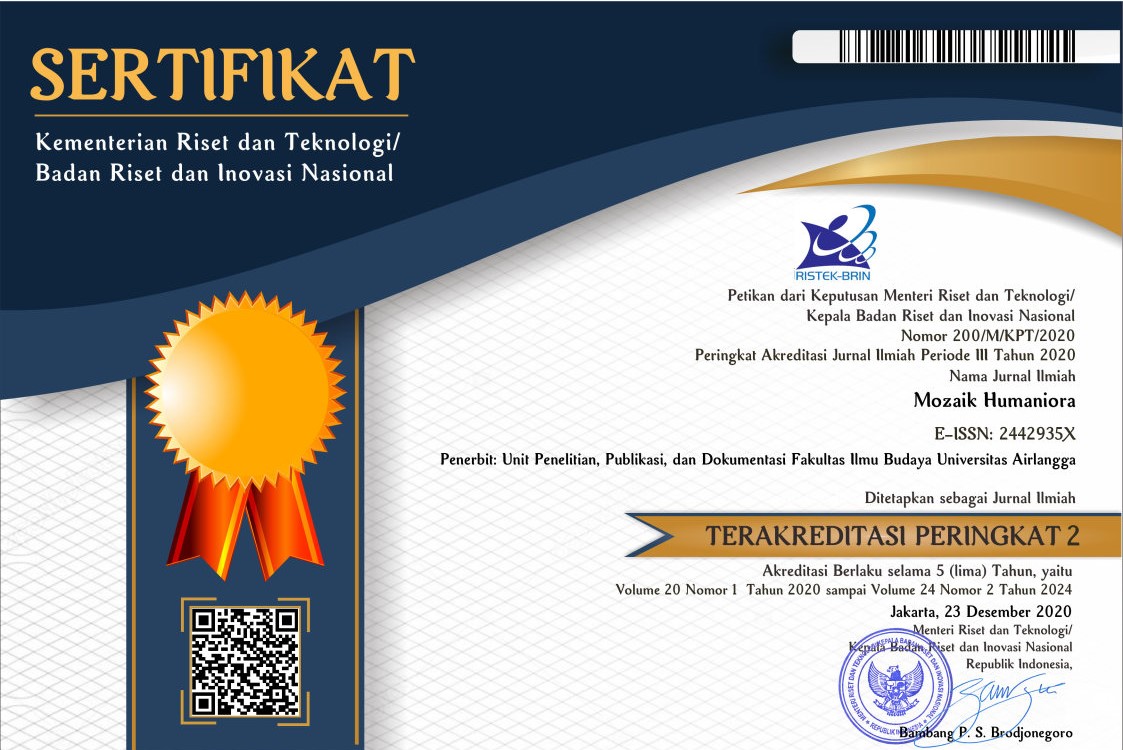Bifurkasi and Turbulensi as Scientific Metaphors in Dee Lestari's Supernova: Ksatria, Putri, dan Bintang Jatuh
Downloads
Abstrak
Supernova: Kesatria, Putri, dan Bintang Jatuh adalah novel karya Dewi (Dee) Lestari yang ditulis pada 2004 dan menghadirkan sejumlah isu terkait kehidupan manusia. Novel ini dapat dianggap sebagai fiksi ilmiah mengingat adanya sejumlah metafora ilmiah di dalamnya. Metafora ilmiah yang dimanfaatkan pada khususnya berasal dari fisika modern (Teori-teori Quantum), matematika, psikologi, biologi, dan ekonomi. Permasalah yang dianalisis dalam artikel ini adalah konsep dasar metafora ilmiah yang memiliki peran penting dalam memahami cerita novel ini. Telaah ini difokuskan pada istilah bifurkasi (bifurcation) dan turbulensi (turbulence) dalam kaitannya dengan teori Order dan Chaos, sebagai salah satu teori ilmiah yang dibicarakan di dalam novel. Telaah ini membahas bagaimana istilah ilmiah dimanfaatkan di dalam novel sekaligus memiliki kaitan dengan penceritaannya, serta memengaruhi interpretasi pembaca atas cerita secara umum. Pendekatan puitika kognitif Peter Stockwell dimanfaatkan untuk menelaah permasalahan tersebut. Melalui pemetaan konsep metafora ilmiah yang digunakan di dalam novel, ditemukan bahwa birfurkasi dan turbulensi menghadirkan sejumlah makna ketika keduanya dikaitkan dengan cerita.
Kata-kata kunci: bifurkasi, metafora ilmiah, puitika kognitif, teori Order dan Chaos, turbulensi
Abstract
Supernova: Ksatria, Putri, dan Bintang Jatuh is a novel penned by Dewi (Dee) Lestari in 2004 that brings many issues of human living in the vast universe. It appears to be science-fiction work since there are several uses of scientific metaphors emerged in the novel. The scientific metaphor uses are especially derived from modern physics (Quantum Theories), mathematic, psychology, biology and economy. The problem that is analyzed in this study is the underlying concept of some scientific metaphors that hold the crucial point in understanding the story. The study is focused on the use of term bifurkasi (bifurcation) and turbulensi (turbulence) for their connectedness to Order and Chaos theory, as one of the science theories discussed in the novel. The study discusses the way the scientific terms are used within the story and intertwined to its narrative, affecting the reader's interpretation of the story in general. Cognitive poetic approach by Peter Stockwell is used to view the problem. By mapping the conceptual metaphor of the scientific terms used in the novel, the study finds that both terms represent their own meanings when they are connected to the story.
Keywords: bifurcation, cognitive poetic, Order and Chaos theory, scientific metaphor, turbulence

Mozaik Humaniora is licensed under a Creative Commons Attribution-ShareAlike 4.0 International License. Both authors and Mozaik Humaniora agree with the following attribution of journal:
1. Copyright of this journal is possession of Author, by the knowledge of the Editorial Board and Journal Manager, while the moral right of the publication belongs to the author.
2. The journal allows the author(s) to retain publishing rights without restrictions
3. The legal formal aspect of journal publication accessibility refers to Creative Commons Attribution Share-Alike (CC BY-SA).
4. The Creative Commons Attribution Share-Alike (CC BY-SA) license allows re-distribution and re-use of a licensed work on the conditions that the creator is appropriately credited and that any derivative work is made available under "the same, similar or a compatible license”. Other than the conditions mentioned above, the editorial board is not responsible for copyright violation.


















